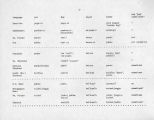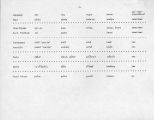| OCR Text |
Show Washins C :?s Pet Papery or The Possession of Pets Dogs, and Other Beasts (Both Animal and HumanI in Southern California, and Surrounding Areas Wick E0 Miller University of Utah Wick R. Miller Dept. of Anthropology Univ. of Utah Salt Lake City, Utah 84112 My introduction to the study of American Indian langua*. ;an with Acorna* As is always the case with onef?s first field language f. I found it inten|ly exciting 9 with numerous eresting and disconnected facts surfacing., far more than Id be properly digested or understood by the novice field worker,, One m was the fact that animals could not be directly possessed, but instead a classificatory noun9 which I will gloss as "pet", had to be useds "my mule"^ "my chicken"? "my camel" and the like becaae "my pet mule", f1my pet chickenT% at camel". I soon ran across a Southern California language (I don*t remember which one) that also used a "pet" assifier. Not being too slowJ? it occurred to me that maybe is was an areal feature, and indeed it has proven to be so0 has been difficult to get a handle on it9 however, because lished reports ai-e often spotty, and lack of report doesn't prove its absence,, To satisfy my curiosity of more than o decades9 I papered the country with a questionnaire. le there are still some important lacunae, the general pattern is clear, thanks to the kindness of the large number people who answered my queries„ I will refer to the use of this classifier as the "pet" phenomenon9 which occurs in either a 3trong form (the "pet" word must be used with possessed animals), or in a weak or -enuated form (it is optionals or is used in only certain rcumstances), While I gloss the classifier as "pet", in every case in which there is sufficient information, the meaning does not refer simply to an animal that is x owned, but to one that is dominated^ domesticated9 or tamed. Its meaning is often extended to "dog", less often to other animals, |


















